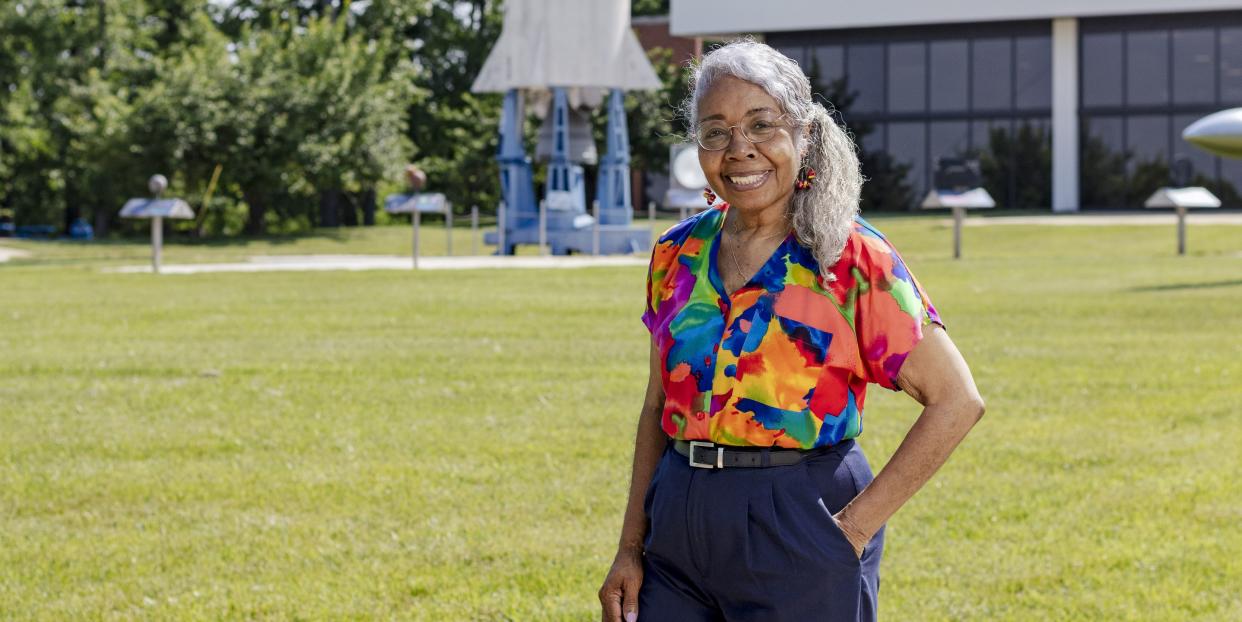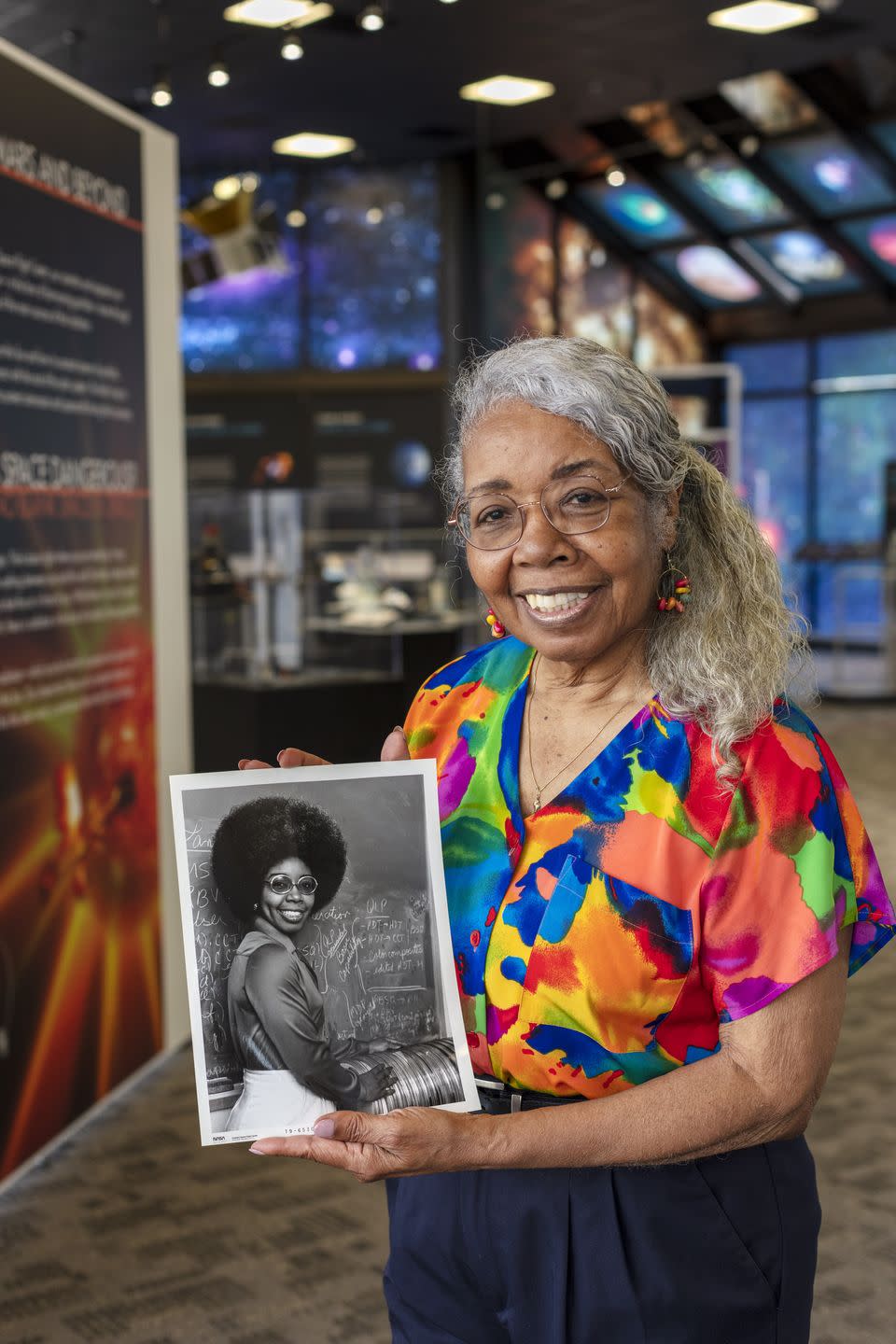78-Year-Old Valerie Thomas Invented Technology That Led to the Creation of 3-D Imaging

“Hearst Magazines and Verizon Media may earn commission or revenue on some items through the links below.”

As told to by Sara Bey/
Photograph by Sahar Coston-Hardy
In 1995, Valerie Thomas, 78, retired as associate chief of NASA’s Space Science Data Operations Office. She invented technology that led to the development of 3-D imaging, but is most proud of the work she’s done to help fellow Black scientists—and future scientists—succeed. —as told to Sara Bey.
“When I was young, TVs were much different. The TV we had was in a big box and had tubes in it that were sort of like lightbulbs. When they blew out, the TV didn’t work. When my father would open the box up, I could see these mechanical parts and the tubes, and I thought How do these mechanical parts result in an image on the screen? I never asked my father, but I was curious about that.
We didn’t always have a library in my community, but when they finally opened one, I went and was looking around for some books to get, and I came across one that really captured my attention. I’m turning the pages and I can see these designs, like illustrations of actual projects you could make. I was so excited. I could not wait to get home and show it to my father so he could show me how to make these projects. The book was called The Boys First Book in Electronics. I took it home, showed it to my father, and he said ‘Oh, I can do that. I can do that, and that.’ He did not show me how to do anything. So, the book just sat until it was time to return it to the library. When I went to the library to return my books, and I was looking around for more, I came across another book that caught my attention, and I took that home. That book was called The Boys Second Book in Electronics, and the same thing happened. So, I got the indirect hint: Electronics is not for girls. Go sew with your mother, or do hair like your mother. I decided to, you know, master my sewing. I taught myself how to do hair. However, I still wanted to know about electronics. I thought maybe when I get to junior high school I’ll learn about electronics.
When I got to junior high school, there were no classes on electronics. When I got to high school, there were no classes on electronics, so I sort of gave up. Then, I took a class in physics and it helped to answer the question that I always had: What makes things tick? So, in my senior year when I was trying to decide on what I wanted to major in, I figured physics would be what I need to pursue. I went to Morgan State and while I was there they started offering a new mathematics course, Abstract Algebra, that students had to get permission from the head of the department to take. First day of class, the professor was going over his lesson, and when I opened the textbook, it looked like Greek to me. The professor was going over this mathematical proof, and he says, ‘…and this is true by induction.’ My hand goes up. ‘What’s induction?’ Well, it turns out induction had several steps that if you already knew wouldn’t be put in the proof. He wrote in three additional lines explaining what induction was, and continues. Then he says, ‘…and this is intuitively clear.’ My hand goes up. ‘What’s intuitive?’ Same thing. I’m sure the other students did not understand what the professor was talking about either. They didn’t ask the question. I asked the questions. I got the answer for all of us, and it turns out I aced the course.
During my senior year, recruiters came out, and I was telling them that I was going to grad school, so not one of them called me back. However, as I got closer to graduation I decided I needed to get a job instead, and I finally heard from NASA. The person asked me when did I want to start work, and I said Monday after graduation. He said, ‘Don’t you want to take a vacation first?’ I mean, I didn’t have any money for a vacation. I hadn’t even thought about a vacation. So I said "Okay, the second Monday after graduation.” And that’s when I started work at NASA as a mathematician data analyst.

I felt like I had gone from one college campus to another. When I started, I had to write programs for computers—I had never seen a computer before in my life except in science fiction movies. I made a decision that I was going to learn everything I could about computers, inside and out. I always wanted to learn and figure things out myself; at NASA, I had a lot of opportunities to do that. Being in an environment where everybody’s smart was really gratifying. I enjoyed working on things that hadn’t been done before and getting to be in charge of some of those things. But I wasn’t getting promoted, and other [African Americans] were going through the same thing. So, I had to fight the good fight, in a positive way. I was part of creating an organization called: Humanitarian United Effort. We put together informal activities that would allow these African Americans who were coming in and doing a good job but were in the shadows, and high-level managers to get to know each other. I also worked with one of the higher-ups who was interested in diversity, to pull together a group representing African American women, Hispanics, people with disabilities, that would give presentations to managers on the importance of diversity. Those are soft, positive ways of addressing the issue, and they helped.
I also took every opportunity I had to let young people know how important it was to take advanced mathematics courses in high school, because nobody had ever told me. So, I would go out to talk with students and sign up to be a mentor to interns. I would get some of the other employees to be mentors through all kinds of programs. I became president of the National Technical Association, which focused on helping African Americans progress in the science and technology fields. Then I went on to lead SMART which focused on education outreach about the space sciences. Now, I’m director of a chapter of Shades of Blue, which prepares young people for careers in aviation.
I had not thought about my legacy before, but now as I look back on the things that I have done, I think my biggest legacy is the positive impact that I’ve had on people. I recently gave a Zoom presentation to a class at a math and science school in the Bronx. The video wasn’t working, so I could see them, but they couldn’t see me. I started telling my stories and I could see that they were doing what I did when I was growing up listening to the radio—they were visualizing in their mind and that will have a great impact on them. There was something that clicked with that presentation. That’s the kind of legacy I’m proud of. My purpose in life is to help people and cause positive things to happen. Like, now I’m helping design a science center that’s a combination space port and theme park. It’s going to have a lot of information on contributions by African Americans. It’s exciting!”
About the Journalist and Photographer
Turn Inspiration to Action
Consider donating to the National Association of Black Journalists. You can direct your dollars to scholarships and fellowships that support the educational and professional development of aspiring young journalists.
Support The National Caucus & Center on Black Aging. Dedicated to improving the quality of life of older African Americans, NCCBA's educational programs arm them with the tools they need to advocate for themselves.
Credits: Sahar Coston-Hardy: Hasani Gabriel
This story was created as part of Lift Every Voice, in partnership with Lexus. Lift Every Voice records the wisdom and life experiences of the oldest generation of Black Americans by connecting them with a new generation of Black journalists. The oral history series is running across Hearst magazine, newspaper, and television websites around Juneteenth 2021. Go to oprahdaily.com/lifteveryvoice for the complete portfolio.

You Might Also Like

